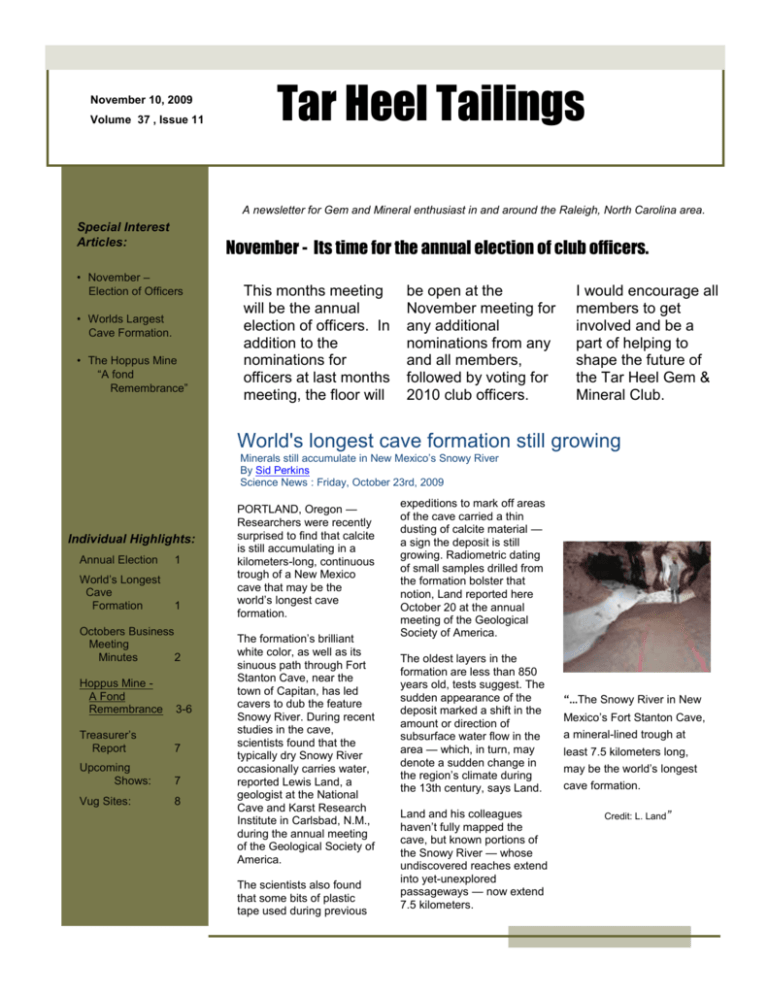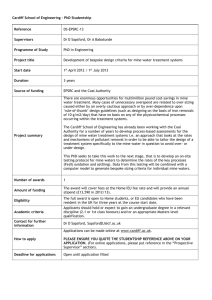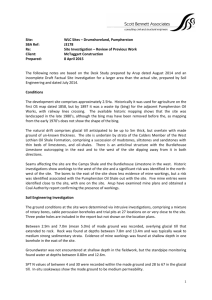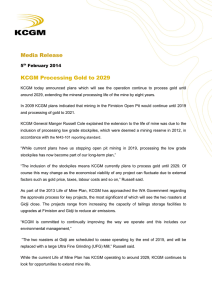“Hi Craig, Here are the minutes from the past meeting and you
advertisement

November 10, 2009 Volume 37 , Issue 11 Tar Heel Tailings A newsletter for Gem and Mineral enthusiast in and around the Raleigh, North Carolina area. Special Interest Articles: November - Its time for the annual election of club officers. • November – Election of Officers • Worlds Largest Cave Formation. • The Hoppus Mine “A fond Remembrance” This months meeting will be the annual election of officers. In addition to the nominations for officers at last months meeting, the floor will be open at the November meeting for any additional nominations from any and all members, followed by voting for 2010 club officers. I would encourage all members to get involved and be a part of helping to shape the future of the Tar Heel Gem & Mineral Club. World's longest cave formation still growing Minerals still accumulate in New Mexico’s Snowy River By Sid Perkins Science News : Friday, October 23rd, 2009 Individual Highlights: Annual Election 1 World’s Longest Cave Formation 1 Octobers Business Meeting Minutes 2 Hoppus Mine A Fond Remembrance 3-6 Treasurer’s Report 7 Upcoming Shows: 7 Vug Sites: 8 PORTLAND, Oregon — Researchers were recently surprised to find that calcite is still accumulating in a kilometers-long, continuous trough of a New Mexico cave that may be the world’s longest cave formation. The formation’s brilliant white color, as well as its sinuous path through Fort Stanton Cave, near the town of Capitan, has led cavers to dub the feature Snowy River. During recent studies in the cave, scientists found that the typically dry Snowy River occasionally carries water, reported Lewis Land, a geologist at the National Cave and Karst Research Institute in Carlsbad, N.M., during the annual meeting of the Geological Society of America. The scientists also found that some bits of plastic tape used during previous expeditions to mark off areas of the cave carried a thin dusting of calcite material — a sign the deposit is still growing. Radiometric dating of small samples drilled from the formation bolster that notion, Land reported here October 20 at the annual meeting of the Geological Society of America. The oldest layers in the formation are less than 850 years old, tests suggest. The sudden appearance of the deposit marked a shift in the amount or direction of subsurface water flow in the area — which, in turn, may denote a sudden change in the region’s climate during the 13th century, says Land. Land and his colleagues haven’t fully mapped the cave, but known portions of the Snowy River — whose undiscovered reaches extend into yet-unexplored passageways — now extend 7.5 kilometers. “…The Snowy River in New Mexico’s Fort Stanton Cave, a mineral-lined trough at least 7.5 kilometers long, may be the world’s longest cave formation. Credit: L. Land” Tar Heel Tailings Page 2 of 8 October Meeting Minutes; “Hi Craig, Here are the minutes from the past meeting and you missed a big one! Where were you?? Also, I had several folks take a look-see over what I wrote up and everything is in accurate form to print as is. There is alot here so I hope you are ready for it. Have fun! And listen for you soon. Obsdian Harris Tar Heel Meeting minutes Tues. 10-20-2009 Head Count of attendance 24 Matt called the meeting to order. September meeting minutes were clarified and carried. As part of the minutes did not show up in the newsletter nor did where they go show up. The Treasurer's report was issued and carried. As this report did not show up in the newsletter. The Door Prize Winner is Trude McLaughlin! She chose a calcite and onyx mineral mix specimen. Congratulations! The upcoming Auction for the Herkimer Diamond stock will be this coming November meeting. So mark that date! Matt is researching locations where a charitable contribution can be made. Nancy gave a mentinon regarding a Geologist's Scholarship also. Tom addressed the Club about the past trip to the Morefield Mine trip in Amelia, Va. And did some pictures for the web site also. Lots of nice minerals there one major one being Amazonite. Matt also brought to people's attention about the upcoming elections in November. And folks nominated the following. President Walt V. P. Cyndy Secretary Obsidian Treasurer Corrine Obsidian the current serving Sec. inquired of folks if someone would take the post to which George replied " I nominate the present serving party". To which to there was much laughter. Was there alot of material of stones/minerals that went into the Grab Bag construction. Each big tray were 25 bags. And each small tray were 20. And there was 12 big trays, 4 small trays and 1 small tray with 14 bags. For a total of 394 bags in all. When requesting peoples help in storing the bags till the Tar Heel G&M show in April of 2010. Mark Lovick graciously volunteered to store the Grab Bags till the Show in April. Wow! Good Man Mark! Good Man! And many Thanks to everyone who showed up at the meeting and helped! WooHoo! Have fun! Happy Rock Hounding! Obsidian Harris” Newsletter Editor’s Notes: These meeting minutes as received indicate that the Treasuer’s Report did not show up in the Newsletter; September’s Treasuerer’s report was not received until Nov. 8th and is included in this newsletter as received. The meeting minutes indicate that “part of the minutes did not show up in the newsletter…”; On October 18th a portion of my request for information; Was there any kind of a business meeting? What information can you share with me? “There was no business meeting.” What information can you share with me? How much did the club bring in with that auction? The treasurer will know the final dollar amount. Who won the raffle? What did they choose for the prize? “As for further comments on the minutes there was around 50 or so people attended. And the Silent Auction went into action.” “one last thing I left out from the notations. As for the Door prize winner there was one however, I did not get their name. And I also learned that they decided to wait to choose their item. So there you are. Have fun! Obsidian” As for where I was; I was with the club’s newest 6-day old member, his name is Lucas B Potter. Page 3 of 8 Newsletter Title A Fond Remembrance of the Hoppus Mine, Estatoe, Mitchell Co., North Carolina By: Dennis Herman One thousand or more mica and feldspar mines and prospects are known to have been in operation in the Spruce Pine Pegmatite District since the mid 1800s. At least one, the Sinkhole Mine, was originally mined by Native Americans prior to the European invasion. The Hoppus Mine, located on the east side of Penland Road about 1.0 road mile from Estatoe and 2.5 air miles west of Spruce Pine, was one of these old mines. Olson (1944) listed the Hoppus Mine as a feldspar mine with “rum” mica (Muscovite) as its by-product. A second unnamed mine located about 200 meters northeast was probably part of the original Hoppus Mine, and the main products of this shaft and tunnel mine were rum mica and feldspar. The pegmatite at the Hoppus Mine is typical of that found in the Spruce Pine Pegmatite District and consists of Muscovite, Quartz (var. Smoky Quartz), and Orthoclase. Accessory minerals include Alamandine, Apatite-(CaF), Beryl, Biotite, Columbite, and traces of radioactive minerals, such as Autunite, Samarskite-Y,Uraninite and others. The Hoppus Mine’s history is sketchy at best, and information on its dates of operation is scant in the literature. J.C. Olson listed it as abandoned in his report to the North Carolina Geological Survey in 1944. Based on the condition of the site and the size of the trees growing around the old mine and dumps during my visits in 1965 I would speculate that mining operations probably ceased during the 1930s. Improvements to Penland Road occurred sometime after mining operations ended. The new alignment of the road used part of the extensive dump material for the road bed. I found the main open pit flooded on my initial visit to the site in February 1965. The flooding was probably attributed to underground springs that had seeped into the deep mine; the fate of many mines in this area. One can only speculate that the cost of constantly pumping water out of the mine became greater than the return in the mineral sales, thus hastening the mine’s closure. I first learned about the Hoppus Mine from Linten B. Greene, a local mineral collector and dealer who owned Greene’s Rock Shop & North Carolina Mineral Museum near the Blue Ridge Parkway in the Grassy Creek community south of Spruce Pine. Mr. Greene collected and supplied Beryl to the U.S. Government during their post war efforts to obtain Beryllium for light weight metal production in the aircraft industry. I spent many Saturdays visiting Mr. Greene’s rock shop discussing geology and mineral collecting during my junior high and most of my high school years (1961-66). Like many young rockhounds I developed a deep appreciation for the beryl group of minerals. This interest in beryl kept getting reinforced with each visit to Mr. Greene’s shop as I stood mesmerized in front of the display cases that held incredible specimens of Beryl and its varieties Emerald, Aquamarine, and Golden Beryl (Heliodor) from various mines in North Carolina. I was fortunate to live less than a quarter mile from the shop, so I spent every chance I got to visit Mr. Greene and get an education in local geology, not to mention the opportunity to look at his incredible beryl specimens. My parents purchased a house in the Estatoe community in early 1964 so my visits to Greene’s Rock Shop became less frequent. My Mom took me to visit with Mr. Greene shortly after we moved and he told me about the old Hoppus Mine. The mine was known to be a great place for Golden Beryl, with specimens approaching the orange color of the Slocum Quarry (Connecticut) and other New England localities. Mr. Greene showed me some specimens he had collected there in the 1950s. He Tar Heel Tailings Page 4 of 8 encouraged me to visit the mine now that I lived only a mile or so away. The need to visit the mine was overpowering. But, there was one small problem. I had a whole year to wait before I could get my driver’s license, and I wasn’t able to take driver’s education until the following spring term. We were a one car family, and my mother would not allow me to make the nearly one mile hike over the ridge to the mine. At least I had some very good mineral collecting sites closer to the house and I spent a lot of time at these abandoned mine dumps. One cool Saturday in February 1965 I was able to convince Mom to let me ride my bicycle to the old Hoppus Mine. While I scrambled over the mine dump to get acquainted with the site I kept hearing an incredible cacophony of strange cackling sounds I had never heard before. I climbed, more accurately crawled due to the steepness, to the top of the dump, lay on my belly, and looked over the rim to the pit below. There along the edge of the flooded mine were hundreds of Wood Frogs (Rana sylvatica) in various stages of mating behavior. The males were calling and defending their territories trying to attract females. From where I lay prone to the ground I could see the vocal sacs of each male frog as they cackled. Many of the frogs had already paired off and were in amplexus, each male enticing the female to lay her eggs so he could fertilize them. I was awestruck at the sight below me. I was a budding herpetologist and finding an individual Wood Frog during my hikes was always special. What I was experiencing today at the Hoppus Mine was mind blowing! I was experiencing the best of both world’s for me----rockhounding and herping (the act of looking for reptiles and amphibians). I think it was at this moment that my career path was chosen for me. Damn those frogs! Now back to the main topic of the Hoppus Mine. The February daylight waned, the temperature began to drop, and a cold chill forced me to pedal back to the house and share my frog encounter with my Mom and Dad. As usual, they were very supportive, and my younger brother was indifferent, as usual. At least the ground had been broken for a return trip to the Hoppus Mine. The first Saturday in June 1965, after getting my driver’s license, my parents agreed to let me drive the car to the Hoppus Mine. I loaded my collecting gear, one Estwing rock pick, a heavy duty screw driver, my old Army surplus knapsack, and some old newspapers, into the trunk, along with my homemade snake hook just in case I found a rattlesnake or a copperhead. After all, I was a budding herpetologist, remember? Was I forgetting anything else? I scrambled up the steep mine dump to the rim and looked down gazing at the flooded pit with the memory of that recent February day fresh in my mind. No frogs were seen or heard, so I concentrated on looking for Golden Beryl, or any interesting specimens I could find. An hour passed and I had only found one speck of beryl, but it was not a keeper. I suddenly remembered what Mr. Greene had told me last year - check the area on the opposite side of the road from the mine. Carefully, I negotiated the steep road embankment which consisted of rocks and boulders of various sizes (old dump material) and thickly covered by decades of fallen leaves and detritus. I eventually made it safely to the washout below the culvert that diverted stormwater runoff under the road from the old mine. Minutes later there it was, a Golden Beryl crystal sitting exposed in the washout! The inch and a half crystal must have eroded out of the pegmatite and became deposited during previous storm Page 5 of 8 Newsletter Title events. What a lucky find! I wrapped the crystal in some newspaper and gently placed in my knapsack. My footsteps were lighter as I excitedly searched for more goodies. I began to rake the leaf litter away from the pegmatite with my hands to expose the rocks for closer examination. The leaf litter was several inches to more than a foot in most places, and the dappled sunlight shining through the foliage made it difficult to see. At least an hour passed before I made my next discovery. I spied a small Golden Beryl crystal exposed in a medium sized piece of pegmatite. This rock was wedged under several larger rocks and extracting it took nearly 20 minutes. Ouch! The sharp pain I experienced was a reminder that I had forgotten to bring gloves. The jagged quartz and feldspar laden pegmatite pierced my fingers making it painful to move the rocks. With bloody fingers and hands I finally rolled my prized rock toward me to get a better look at the beryl crystal I had seen. The weight of the rock and the steepness of the slope caused it to roll onto my leg, but any pain I may have felt quickly dissipated when I saw the incredible orange 2 to 3 inch hexagonal crystals on the opposite side. I really do not remember what happened in those moments after making this discovery. By the time my mind returned to the task at hand, I was desperately attempting to carry the 40-50 pound rock up the steep slope to the car. It was only after I placed the specimen and my collecting gear in the car’s trunk did I notice the blood on my hands and arms, and the aching in my back and legs. My shirt was ripped and torn from carrying the sharp pegmatite boulder up the steep slippery embankment, and I barely remembered the drive back to the house. My parents greeted me on my return, and my Dad helped me remove the prized specimen from the trunk. My Mom could only comment on my bloody arms and hands and spent the next 15 minutes playing Florence Nightingale, patching my wounds. I spent the next two hours cobbing the pegmatite down to carefully expose the beryl crystals into cabinet sized display pieces that would fit in my display case. As the pegmatite chipped away, more and more beryl crystals were exposed, and some popped free of the matrix no matter how gently I tried to prevent it. Eventually, I was able to obtain several nice cabinet specimens with single and multiple crystals in matrix and a couple of single crystals. The individual crystals measured from less than 1 inch to 4 inches in length and over an inch in diameter. Each crystal was more or less orange in color and some contained small gemmy windows, but none large enough to facet. I was able to visit the Hoppus Mine a few times after my beryl discovery, but each was met with mixed success. The most exciting find occurred on my next visit. I found a greenish blue tinged mineral that resembled beryl, but appeared to be softer. Most of the specimens I found were not in crystal form, although a few had single crystal faces. On closer examination of the mineral I realized that it was Apatite (this was long before I became aware of Fluorapatite or Apatite-[CaF]), and it was rather abundantly found. One partial crystal was around 3 inches in diameter, while another was a small thumbnail size greenish blue crystal in matrix. I collected all of the specimens that I found and carried them to the car. Another search netted some massive Columbite and one very nice small crystal with shiny blue faces. I noticed that all of the Alamadine garnets I found were broken, and a halo was evident around many of the broken crystals. Some of the material associated with the garnet laden rock was submetallic in luster and halos encircled them, too. I tentatively identified these minerals as Uraninite, and the halos were radiation marks. I also found some nice Muscovite crystals in the pegmatite. It was time to take my finds home to clean and cob them into display specimens. Tar Heel Tailings Page 6 of 8 Several years passed and I had not thought much about the various Hoppus Mine specimens I had displayed or boxed and stored. I was fortunate to buy a nice Mineralight with both long and short wave UV capabilities. This was not one of the smaller versions of lights available, and it took many months of saving money before I could buy it. My first weekend visit from college after purchasing the UV light I decided to check my collection to see what would fluoresce under the two wavelengths. My Hyalite specimens were vivid green, as was my nice Autunite from the old No. 20 Mine. As the light passed over the Hoppus Mine apatite specimens I noticed them fluoresce a pale yellow color, but what I observed next totally floored me. Most of the apatite in matrix pieces had areas of intense green fluorescence. At that moment it was obvious that this apatite was associated with Autunite. On close inspection of the specimens I finally noticed some yellow color and tiny flakes of Autunite. I never used a loupe to examine the specimens initially, so I missed seeing it. Some specimens had a lot of green fluorescence while others had little to none. I carefully wrapped all of these specimens and put them back into the box to store them. I kept only a few specimens out for the display case. The career path I chose involved herpetology (remember the frogs?) while my mineral collecting remained a hobby of sorts. I was able to enjoy both my vocation and avocation during trips to collect amphibians and reptiles around the country. I have collected many nice ammonites and other Cretaceous marine fossils in Texas, trilobites and plant fossils in northwest Georgia, and Pleistocene fossils on Edisto Island (SC), and mineral specimens in Arizona and Texas during herpetological field work, and I visited the annual gem and mineral shows in the Atlanta area while living there for 25 years. In the past three years I have directed my attention more on my hobby. I have numbered each specimen and created a database which will include maps and photos of the localities and specimens in my collection. I decided to concentrate on North Carolina minerals and share some of my past finds with others. It had been 30+ years since I last opened the box of Hoppus Mine specimens, and it was time to become familiarized with them again. I scanned my small portable UV lamp (my Mineralight was stolen many years ago) over the specimens and watched the green of the Autunite dance around the yellowish tinge of the Apatite-(CaF). Seeing this light display and the specimens, again, made my mind race back to those carefree days of youth when I visited the Hoppus Mine and found my first Golden Beryl and Apatite-(CaF) associated with Autunite. The aching back and legs, and those bloody arms, hands and fingers were a small price to pay for a lifetime of memories. Reference Olson, J.C. 1944. Ecomonic Geology of the Spruce Pine Pegmatite District, North Carolina. N.C. Geological Survey Bulletin. Raleigh, N.C. 67 pp. (6 figs., 4 tables, 10 plates). Specimens in the Dennis W. Herman collection: Apatite-(CaF) a small blue-green crystal, and massive specimens associated with Autunite in pegmatite matrix Autunite small crystal flakes (almost invisible) associated with Apatite-(CaF) in pegmatite matrix Beryl var. Golden Beryl several specimens of single crystals and multiple crystals in pegmatite matrix Biotite specimen associated with white Muscovite on the pegmatite Columbite small crystal in pegmatite matrix Muscovite crystals in pegmatite matrix Page 7 of 8 Tar Heel Gem & Mineral Club Newsletter Title Treasurers Report: Sep.1 Beginning Balance Deposit Dealers Deposit Members Deposit Auction 513 Carolyn Ct. Cary, NC 27511 ______________________ Matt Cook – President mattcook@nc.rr.com (919) 451-5881 Sub Total $20,501.72 $1,655.00 $60.00 $1,845.00 . $24,061.72 Expense Newsletter Expense Meeting Food Sep. 30 Ending Balance $214.64 $75.00 $23,772.08 Oct. 1 Beginning Balance No Deposits Expense Newsletter $131.32 Expense Ladds Insurance $453.00 Ladds Insurance $348.00 $932.32 Oct. 31 2009 Ending Balance Walt Milowic – V-President wmilowic@nc.rr.com (919) 327-3227 Librarian Report Obsidian Harris – Secretary foxivy@nc.rr.com (919) 674-02432 A reminder from Bob; There is still one faceting machine available for any club member that wishes to borrow it. Two other loaner machines should be returned by the 2010 Club show. Corinne Hummel – Treasurer mchummel@mindspring.com (919) 779-6220 Bob Bendelow – Librarian & Committee Member r.bendelow@earthlink.net (919) 552-8175 Presidents Message: Kenny Gay – Committee Member kenny.gay@ncdenr.gov (919) 604-2376 Craig Potter – Newsletter Editor cpotter919@gmail.com (919) 441-8901 Tom Todaro – Field-Trip Coord. caribtomt@yahoo.com (919) 639-7798 We’re on the Web! See us at: www.tarheelclub.org Program & Refreshments This month’s program will be voting for officers of the next THG&MC $23,772.08 REFRESHMENT SCHEDULE: November – OPEN December – No Meeting PROGRAM SCHEDULE: November – Elections December – No Meeting Upcoming Local Events DEC 5-7, GREENSBORO, NC - Greensboro Gem & Mineral Club. 35th annual Gem and Mineral Show at the Greensboro Coliseum, 1921 West Lee Street, Friday, 2 PM to 7 PM. Saturday, 10 AM to 6 PM Sunday, Noon to 5 PM JAN 30 - FEB 14, 2010 Tucson, AZ, The largest Gem, Jewelry & mineral show in the world. APRIL 9,10,11 – RALEIGH, NC: Annual Tarheel Gem & Mineral Show, Free Admission, $22,839.76 November B-Day Members Jan Schetzina Deborah Miller Jerry Miller Austin Neaville Jonathan Starke Heather Chrisey Jason Boyd George Crowel Tom Davis Valerie Eakley Melissa Ellis Scott LaBorde Joanne Lee Linda Vaughn-Burd Tom Bapple Tristan Barbour Mark Bloom Vugsites The following are some links to Web-Sites that may interest some of our members: http://www.msnbc.msn.com/id/29726500/ns/technology_and_science-science This site highlights a half dozen of the most recent significant fossil finds. http://www.amfed.org / http://www.amfed.org/sfms These are the official sites for the organizing body that the Tar Heel Gem & Mineral Club is founded under. I would strongly urge all members to check them out on a regular basis. http://www.rockhoundlounge.com Scott Laborde a member of our club maintains his own web site that might be of interest to people collecting in and around Wake County. I would like to encourage all members of the THG&MC that maintain their own presence on the internet to send me a link to their site to be published in future Vugsites so that other club members may learn and enjoy the craft, the art, the interests that many of us have in common. Park in the Cates Ave. Parking Deck off Jensen Dr. Enter Thompson Building directly across from the parking lot. Next Meeting November 17, 2009 @ 7:30PM About Our Organization… The Tar Heel Gem and Mineral Club was formed in 1974 as a nonprofit educational organization for people who enjoy the lapidary arts, earth sciences, and related subjects. The main objectives of the club are to investigate, preserve, and share knowledge of rocks, minerals, and precious stones, and to promote interest in mineralogy, paleontology, earth sciences, and lapidary techniques, among club members and among the general public. The club pursues these goals through publications, meetings, lectures, field trips, exhibits, demonstrations, and other activities. Come and be a part of the Fun! TAR HEEL GEM & MINERAL CLUB 513 Carolyn Ct. Cary, NC 27511








